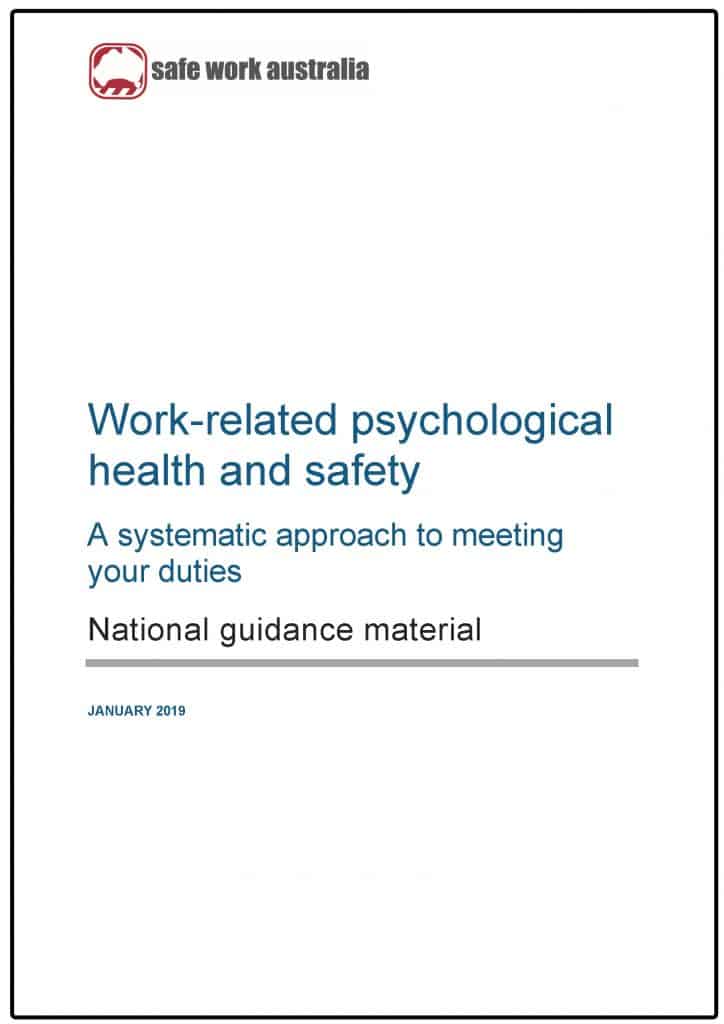
Safe Work Australia (SWA) quietly released an amended version of its “Work-related psychological health and safety: A systematic approach to meeting your duties” recently. SafetyAtWorkBlog looks at what has changed.
The original file included a chapter headed “Provisional Liability” which has been shifted giving more prominence to “What is meant by recovery and return-to-work?”. The original information remains; however, the text identifies a weakness in the guidance.
“A long period away from work can undermine working relationships and has been shown to lead to poorer RTW outcomes for injured workers. ”
page 27
Any occurrence of the phrase “has been shown” should be accompanied by a reference to the source of the evidence that shows this “fact”. This phrase strongly implies that there is evidence and SWA should point the reader to this evidence. One of the, perhaps snobby, criticisms of the first guidance was that it is not research but a position statement on the issue agreed by participants in SWA’s tripartite consultation. A position statement can still be authoritative and links to evidence would address some of this criticism.
Some text changes are understandable. For instance, where the original document referred to “doctors” as treating practitioners, the new guidance includes “or other health practitioners” in keeping with the current approach to medical assistance.
A lot of the text changes relate to formatting – a capitalisation here, a hard return for an additional bulletpoint, updated page numbers. One change provides clarity through the deletion of “may”. The new version states:
These laws, although similar in all jurisdictions,
page 26mayhave some variations so it is important to refer to your jurisdiction and ensure you are compliant with relevant laws.
Are there fundamental changes to this guidance? No, but we should not have to ask this question. Most subsequent editions of a book or document has a new Preface or similar which explains the reasons for the editorial and textual changes. Government publications hardly ever do this but should, especially if government as a whole accepts that the level of trust from stakeholders needs improving. A new explanatory Preface is a small change but is also one of those nudges beloved by behavioural scientists.

Hi
Thanks Kevin As the lead for the 2018 document ( I left SWA mid last year) I would just comment that guides and especially codes of practice usually don’t cite references. This is because they aren’t research or persuasive documents but rather advice on how to comply with the laws.
Peta Miller (UNSW)
Thanks Peta. Given the apparent trust deficit in government agencies from the community, I think references would be useful in supporting the governments’ claims for evidence-based policy making. The authors of the Safe Work Australia (SWA) document would already have the references from which they were able to make the statements.
I think this small change, at no additional cost to SWA, would give these OHS documents more authority. Particularly in relation to this psychosocial guidance which seems to be being ignored in the current discussions on workplace mental health, wellness and sexual harassment.
Absolutely ridiculous! There is no guidance here at all, just a bullshit guide where wording is left interpretable so it can be manipulated by employers to over work employees! It will be interesting to see what they will say back.
Thanks for your comment Christine.
Could you provide some examples of how the guidance allows, or encourages, overwork? My reading of the guidance shows long work-hours and high workloads (page 9) as major contributors to psychological ill-health and employers have legal obligation under WHS/OHS laws to eliminate or reduce this risk. I would love to understand your interpretation of the guidance more.
Kevin